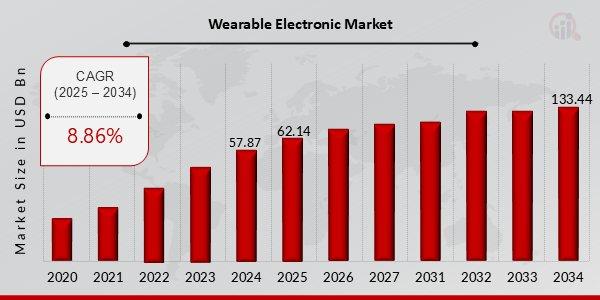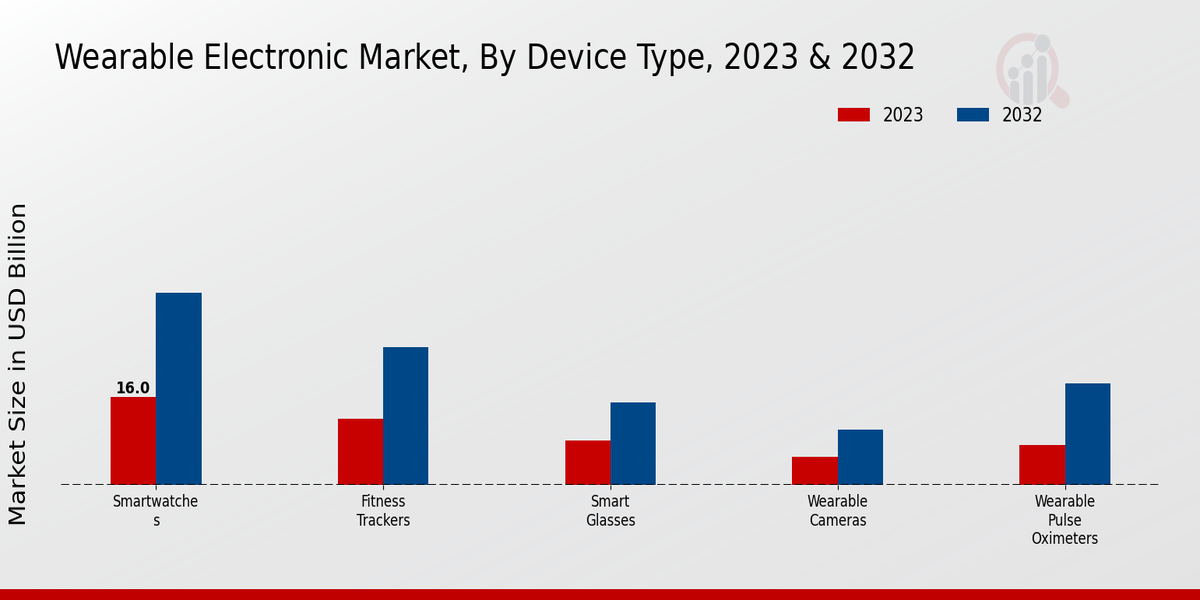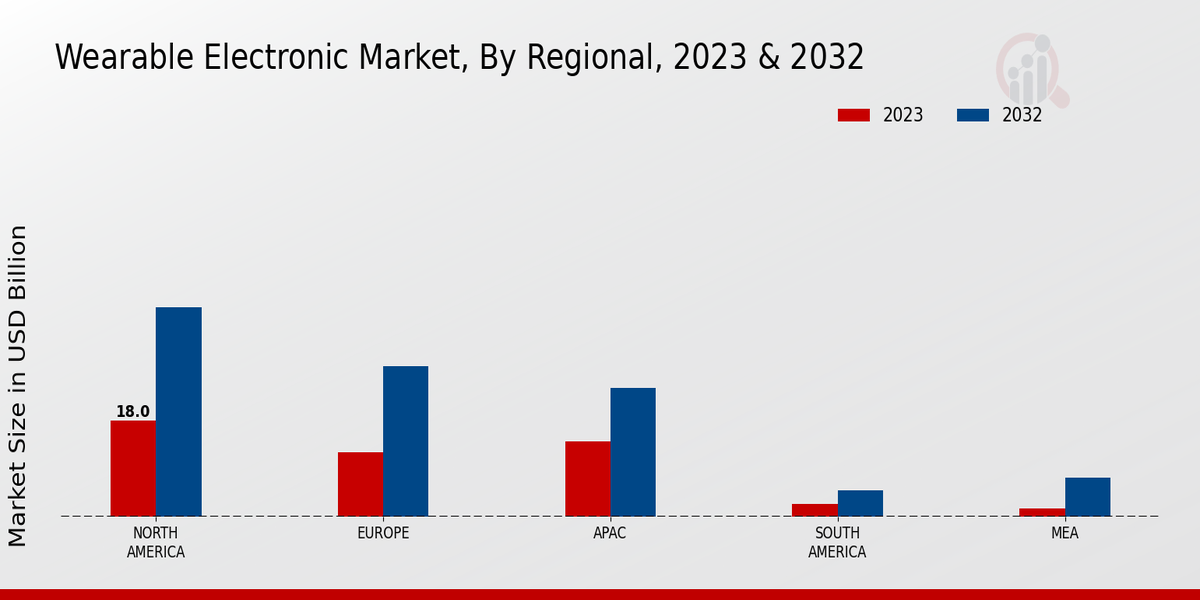Global Wearable Electronic Market Overview
Wearable Electronic Market Size was estimated at 57.87 (USD Billion) in 2024. The Wearable Electronic Market Industry is expected to grow from 62.14 (USD Billion) in 2025 to 133.44 (USD Billion) till 2034, exhibiting a compound annual growth rate (CAGR) of 8.86% during the forecast period (2025 - 2034)
Key Wearable Electronic Market Trends Highlighted
The Wearable Electronic Market is primarily driven by the increasing demand for health and fitness tracking devices, alongside the rise in consumer awareness regarding the benefits of maintaining an active lifestyle. Technological advancements, such as enhanced sensors and improved connectivity options, also play a significant role in driving market growth. The integration of wearable devices with smartphones and other smart technologies enhances user experience and functionality, further boosting their adoption among consumers. Furthermore, the growing aging population has led to a higher demand for health monitoring devices that enable users to track vital signs conveniently, illustrating the market's capacity for expansion.Opportunities in the wearable electronic market are ample, particularly in developing regions where the penetration of smart technology is increasing. Innovations in smart clothing and wearable health monitors offer numerous avenues for market players to explore, catering to diverse consumer needs.
Enhanced data analytics and artificial intelligence integration can further improve the functionality of wearables, offering personalized health insights to users. Additionally, collaborations between technology companies and healthcare providers can unlock new potentials in remote patient monitoring and telehealth services, making healthcare more accessible and efficient.Recent trends in the wearable electronic market include a shift towards multifunctional devices that extend beyond fitness tracking. Consumers are increasingly seeking wearables that provide comprehensive health monitoring, such as those that can detect irregular heartbeats or monitor stress levels. The rise of augmented reality (AR) and virtual reality (VR) technologies in wearables also indicates a changing landscape. Sustainable design and eco-friendly materials are becoming more important to consumers, prompting companies to innovate responsibly. Overall, the landscape of the wearable electronic market is dynamic and continuously evolving in response to technological advancements and consumer preferences.

Source: Primary Research, Secondary Research, MRFR Database and Analyst Review
Wearable Electronic Market Drivers
Increasing Health Awareness and Fitness Trends
One of the most significant drivers contributing to the growth of the Wearable Electronic Market Industry is the rising awareness of health and fitness among consumers. With the increasing prevalence of lifestyle-related diseases such as obesity, diabetes, and hypertension, more individuals are seeking innovative solutions to monitor their health effectively. Wearable electronics, such as smartwatches and fitness trackers, provide users with real-time data about their physical activity, heart rate, sleep patterns, and more.This data is essential for individuals aiming to improve their health, as it empowers them to make informed decisions about their fitness regimes. Furthermore, the integration of advanced technologies in wearable devices, such as artificial intelligence and machine learning, enhances their capabilities and accuracy, making them more appealing to health-conscious consumers. As the market evolves, manufacturers are focusing on creating more refined and sophisticated products that cater to diverse health needs.Moreover, various organizations and communities are promoting fitness initiatives, encouraging individuals to adopt healthier lifestyles, thereby creating a favorable environment for the Wearable Electronic Market. Additionally, with the increasing engagement in corporate wellness programs and preventive healthcare measures, wearable technologies are being adopted in workplaces and fitness centers. The combination of increased consumer awareness, innovative product offerings, and strategic marketing initiatives is likely to drive significant growth in the Wearable Electronic Market in the coming years.
Technological Advancements in Wearable Devices
Technological advancements are a critical driver for the growth of the Wearable Electronic Market Industry. With the rapid evolution of technology, manufacturers are continuously innovating their product offerings, incorporating features that enhance user experience and functionality. Modern wearable devices are equipped with advanced sensors, GPS tracking, heart rate monitors, and compatibility with various mobile applications, which significantly improve their effectiveness.This continued innovation attracts new customers and retains existing users, boosting the overall market growth. Furthermore, developments in battery technology ensure that wearable devices have longer battery life and energy efficiency, making them more practical for daily use.
Growing Demand for Connected Devices
The increasing trend towards smart homes and connected devices has fostered a heightened demand for wearable electronics in the Wearable Electronic Market Industry. Consumers are increasingly looking for devices that seamlessly integrate with their existing ecosystem of connected technologies, such as smartphones, smartwatches, and other Internet of Things (IoT) products. This demand encourages manufacturers to design wearable devices that can easily connect and share data with other devices, providing users with a more cohesive and efficient experience.As wireless technology and communication protocols improve, the market is likely to see sustained growth driven by the desire for enhanced connectivity and control.
Wearable Electronic Market Segment Insights:
Wearable Electronic Market Device Type Insights
The Wearable Electronic Market is witnessing significant growth within the Device Type segment, attributed to a diverse array of products catering to various user needs. In 2023, the market showcased Smartwatches, being the dominant force valued at 16.0 USD Billion and projected to reach 35.0 USD Billion by 2032, reflecting their popularity due to advanced features such as health monitoring and connectivity. Fitness Trackers also represent a substantial portion of the market, valued at 12.0 USD Billion in 2023, expected to rise to 25.0 USD Billion by 2032, driven by the increasing health consciousness among consumers, promoting active lifestyles and fitness management solutions. Smart Glasses, while smaller in market share, play a significant role in specialized applications, valued at 8.0 USD Billion in 2023 and anticipated to grow to 15.0 USD Billion by 2032, highlighting their importance in fields like augmented reality and hands-free functionalities for various industries. Wearable Cameras, valued at 5.0 USD Billion in 2023 and growing to 10.0 USD Billion by 2032, are gaining traction among outdoor enthusiasts and content creators, enhancing user experiences in capturing moments hands-free, underlining the merging of technology with everyday life.Lastly, Wearable Pulse Oximeters, valued at 7.17 USD Billion in 2023 and expected to increase to 18.39 USD Billion by 2032, have become crucial in healthcare settings, providing real-time monitoring of oxygen saturation levels, especially significant during health crises like the COVID-19 pandemic, indicating a rising trend in remote patient monitoring solutions. Overall, the data reveals a robust trajectory for the Wearable Electronic Market, propelled by the versatility and functional relevance of each device type, catering to both consumer and industrial demands while highlighting opportunities for future innovations and market growth.

Source: Primary Research, Secondary Research, MRFR Database and Analyst Review
Wearable Electronic Market Application Insights
The Application segment of the Wearable Electronic Market encompasses diverse functionalities that cater to various user needs. Health Monitoring applications are integral to this segment, facilitating real-time health tracking and promoting wellness among consumers, thus gaining substantial traction. Fitness Tracking also plays a vital role, motivating users to engage in healthy activities, thereby significantly enhancing lifestyle habits. Entertainment applications are emerging, especially in wearable devices, allowing users to enjoy media on the go.Navigation functionality aids users in their daily commute, ensuring convenience and efficiency. Communication applications continue to dominate, simplifying interaction by integrating smartphones with wearable technology. The continuous evolution in wearable technology drives the growth of these applications, presenting opportunities and challenges in managing consumer expectations while innovating accordingly. Additionally, the shift towards fitness and health awareness among consumers serves as a compelling growth driver in this segment. Overall, insights derived from the Wearable Electronic Market data signify a robust trajectory with opportunities for further development and innovation across applications.
Wearable Electronic Market End User Insights
The Wearable Electronic Market, within this segment, athletes are increasingly adopting wearable technology to enhance performance and monitor health metrics, thereby leading to greater accuracy in training regimes. Fitness enthusiasts represent another prominent group, utilizing devices for activity tracking and motivational insights, which further drives demand. Medical patients benefit from wearables through health monitoring solutions that offer real-time data essential for chronic condition management, highlighting the technology’s potential in healthcare settings.General consumers also play a critical role, focusing primarily on convenience and lifestyle integration, which fosters widespread acceptance of wearable technology in daily routines. The fusion of these various user groups demonstrates robust market growth, propelled by advancements in technology and rising health consciousness, alongside challenges including data privacy concerns and varying technological accessibility. Overall, the Wearable Electronic Market segmentation reflects a comprehensive landscape shaped by diverse needs and applications, emphasizing the importance of each user category in driving innovation and adoption.
Wearable Electronic Market Technology Insights
This uptrend is driven by a compound annual growth rate (CAGR) of 8.86 from 2024 to 2032. Technology plays a pivotal role in this market, encompassing various key components that enhance functionality and user experience. Bluetooth technology dominates a large share due to its efficiency in short-range communication and seamless connectivity, making it essential for various wearable devices.RFID technology is vital in personal and healthcare applications, offering efficient tracking and data management. Near Field Communication (NFC) provides a convenient payment solution for users, facilitating contactless transactions, which has seen increased adoption. Wi-Fi technology supports extensive data transfer, enabling wearables to synchronize with other devices, thus expanding their utility. As a result, the segmentation in the Wearable Electronic Market highlights the importance of these technologies in driving market growth and enhancing consumer experiences in diverse sectors.With advancements in these technologies, opportunities for innovation and integration are promising for the industry, making it an exciting segment to watch.
Wearable Electronic Market Regional Insights
The Wearable Electronic Market shows a diverse regional landscape, with North America leading the pack, valued at 18.0 USD Billion in 2023, underscoring its dominant position. Europe follows closely with a valuation of 12.0 USD Billion, reflecting significant consumer adoption and technological advancements in wearable devices. The APAC region represents a notable segment, holding a value of 14.0 USD Billion, spurred by increasing health awareness and a growing middle class. In comparison, South America and MEA are comparatively smaller markets at 2.5 USD Billion and 1.67 USD Billion, respectively, but exhibit growth potential, particularly in health monitoring wearables.North America’s majority holding can be attributed to its robust tech infrastructure and high disposable income, positioning it as a key player in the Wearable Electronic Market industry. Overall, the market growth across these regions indicates strong consumer interest and the rapid evolution of wearable technology, with opportunities emerging in health tracking and smart devices. The segmentation of the Wearable Electronic Market data reveals distinct trends and consumer preferences that drive the industry forward.

Source: Primary Research, Secondary Research, MRFR Database and Analyst Review
Wearable Electronic Market Key Players and Competitive Insights:
The Wearable Electronic Market has experienced significant growth and innovation, characterized by rapid advancements in technology and a burgeoning consumer interest in health monitoring and personal fitness. The competitive landscape of this market is defined by a diverse range of players, from established electronics manufacturers to emerging startups, all striving to develop cutting-edge wearable devices that cater to the evolving demands of consumers. Companies are focusing on enhancing product functionalities, integrating sophisticated sensors, and utilizing data analytics to provide accurate and actionable health insights. The competition is further intensified by the increasing adoption of smartwatches, fitness trackers, and health monitors, leading to a dynamic environment where continuous innovation and strategic partnerships play pivotal roles in capturing market share.Our Health stands out in the Wearable Electronic Market with its unique focus on sleep and recovery tracking through its innovative smart ring. The company has effectively carved out a niche by emphasizing the importance of sleep health, a feature increasingly critical to consumers' overall well-being.
With its sleek design, Oura Health combines advanced sensors that monitor a wide range of biometrics such as heart rate, body temperature, and movement, delivering insights tailored to individual needs. The data provided by Oura's device not only helps users understand their sleep patterns but also offers holistic wellness advice, making it a sought-after choice for health-conscious consumers. Furthermore, Oura Health's user-friendly app enhances the consumer experience by consolidating data into easily interpretable metrics, thereby strengthening its position in a competitive market.Huawei, a major player in the Wearable Electronic Market, has made significant strides with its diverse lineup of products, including smartwatches and fitness bands. The strength of Huawei lies in its robust technology ecosystem and integration with smartphones, making it a compelling choice for consumers looking for connectivity and functionality. The company leverages its expertise in telecommunications to enhance the performance of its wearable devices, incorporating features like GPS tracking, heart rate monitoring, and various workout modes that appeal to fitness enthusiasts. Huawei's commitment to quality and innovation is reflected in its emphasis on battery life and health monitoring, providing users with long-lasting devices that can seamlessly integrate into their daily activities. The brand's marketing strategy, which often includes collaborations and endorsements, further enhances its visibility and appeal in the market, solidifying Huawei's competitive stance in the wearables arena.
Key Companies in the Wearable Electronic Market Include:
- Oura Health
- Huawei
- Misfit
- Withings
- Garmin
- Apple
- Microsoft
- Sony
- Polar
- Fossil Group
- LG Electronics
- Samsung Electronics
- Fitbit
- Xiaomi
- TomTom
Wearable Electronic Industry Developments
Recent developments in the Wearable Electronic Market indicate a growing focus on health and fitness tracking, with companies like Apple and Fitbit expanding their offerings in advanced health-monitoring features. Oura Health has made strides by introducing new sleep-tracking technologies, while Withings continues to innovate in smart health devices. Companies such as Garmin and Polar are also enhancing their fitness-focused wearables, responding to increasing consumer interest in outdoor activities. In terms of mergers and acquisitions, there have been significant moves recently in the market; for instance, the acquisition of Misfit by Fossil Group has strengthened Fossil's portfolio in the wearables space, indicating a strategic alignment with growing consumer health awareness. Additionally, Samsung Electronics has made efforts to integrate more health-related functionalities in its products, particularly focusing on wearables that align with the growing telehealth sector. The market valuation for these companies is on the rise, driven by the surge in demand for personal health tracking and the integration of smart technology into everyday life. This growth is shaping the overall market landscape, fostering greater competition and innovation among key players like Huawei, Xiaomi, and Sony.
Wearable Electronic Market Segmentation Insights
Wearable Electronic Market Device Type Outlook
- Smartwatches
- Fitness Trackers
- Smart Glasses
- Wearable Cameras
- Wearable Pulse Oximeters
Wearable Electronic Market Application Outlook
- Health Monitoring
- Fitness Tracking
- Entertainment
- Navigation
- Communication
Wearable Electronic Market End User Outlook
- Athletes
- Fitness Enthusiasts
- Medical Patients
- General Consumers
Wearable Electronic Market Technology Outlook
- Bluetooth
- RFID
- Near Field Communication
- Wi-Fi
Wearable Electronic Market Regional Outlook
- North America
- Europe
- South America
- Asia Pacific
- Middle East and Africa
|
Report Attribute/Metric
|
Details
|
|
Market Size 2024
|
USD 57.87 Billion
|
|
Market Size 2025
|
USD 62.14 Billion
|
|
Market Size 2034
|
USD 133.44 Billion
|
|
Compound Annual Growth Rate (CAGR)
|
8.86% (2025-2034)
|
|
Base Year
|
2024
|
|
Market Forecast Period
|
2025-2034
|
|
Historical Data
|
2020-2023
|
| Market Forecast Units |
USD Billion |
|
Report Coverage
|
Revenue Forecast, Competitive Landscape, Growth Factors, and Trends
|
| Key Companies Profiled |
Oura Health, Huawei, Misfit, Withings, Garmin, Apple, Microsoft, Sony, Polar, Fossil Group, LG Electronics, Samsung Electronics, Fitbit, Xiaomi, TomTom |
| Segments Covered |
Device Type, Application, End User, Technology, Regional |
| Key Market Opportunities |
1. Health monitoring innovations, 2. Fitness tracking advancements, 3. Smart clothing integration, 4. Enhanced AR/VR experiences, 5. Growing demand for personalization |
| Key Market Dynamics |
1. Technological advancements, 2. Increasing health awareness, 3. Rising adoption rates, 4. Growing fitness trends, 5. Demand for convenience and connectivity |
| Countries Covered |
North America, Europe, APAC, South America, MEA |
Frequently Asked Questions (FAQ) :
The Wearable Electronic Market was expected to be valued at 133.44 USD Billion by the year 2034.
The Wearable Electronic Market is projected to have a CAGR of 8.86% from 2025 to 2034.
Smartwatches are expected to dominate with a market size of 35.0 USD Billion by 2032.
The fitness tracker segment is projected to reach a value of 25.0 USD Billion by 2032.
The market value for wearable pulse oximeters in 2023 was 7.17 USD Billion.
North America accounts for a market value of 18.0 USD Billion in 2023.
Europe's market value is projected to be 28.0 USD Billion by 2032.
Major players include Apple, Samsung Electronics, Huawei, and Fitbit, among others.
Wearable cameras are expected to grow from 5.0 USD Billion in 2023 to 10.0 USD Billion in 2032.
The market for smart glasses is anticipated to grow to 15.0 USD Billion by the year 2032.

















